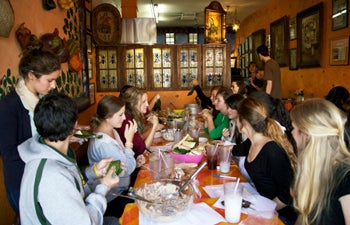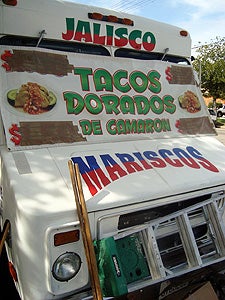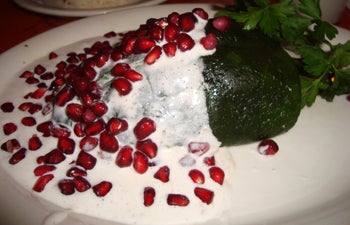A Forkful of Culture
When the plate was set before her, USC Dornsife senior Amy Rogers timidly forked a piece of meat into her mouth and awaited her tastebuds reaction.
The verdict: barbequed goat Oaxacan style was muy delicioso.
“The meat was so tender,” said Rogers, who graduated in May 2012 with a bachelor’s in neuroscience and minors in natural science and Spanish. “Ordering goat taught me how fun it is to try new dishes, especially when the food is from a different culture.”
Having students step outside their comfort zones is a main objective of Sarah Portnoy’s course, “The Culture of Food in Hispanic Los Angeles.” The lecturer in Spanish and Portuguese in USC Dornsife takes her students to restaurants, mercados and street vendors in neighboring cities throughout Los Angeles such as East L.A. and Boyle Heights, where they spark up conversations with managers, employees and other workers. The interactions give students a chance to improve their Spanish skills while experiencing Hispanic cultures using food as the learning tool.

Portnoy accompanied her class to La Casita Mexicana where the restaurant’s chefs taught students how to make tamales. Photo by Kelly Teacher.
The course also broaches larger social issues such as immigration, nationalism, regionalism, business and economics.
“Hispanic food is all around us in L.A.,” said Portnoy who established the class in Spring 2011 with a grant from the USC Center for Excellence in Teaching. “This is an exciting way to connect with cultures by thinking about the meaning of food for each culture. It also allows students to explore the histories and values of these cultures and issues such as gender roles. It’s like going abroad without going abroad.”
L.A. is a hot spot for food from Mexico, but also all parts of Latin America and Spain. Nearly every region of Mexico is represented in the city, with many Oaxacan restaurants within a few miles of USC’s University Park campus. Through visits to food trucks, small family-run eateries and high-end restaurants such as Rivera owned by John Rivera Sedlar in downtown L.A., students learned how these establishments market themselves and about each nationality their food represented.

Jason Duong, who graduated in May 2011 with bachelor degrees in Spanish from USC Dornsife and health promotion and disease prevention from Keck School of Medicine of USC appreciated learning more about the Hispanic food and culture with each eatery he visited, which included the East L.A. food truck, or, lonchera, Marisco Jalisco. Photo by Jason Duong.
Students documented their experiences in blogs that included short videos and photographs. Writing in Spanish, students discussed each eatery’s surrounding neighborhood, ambiance, decor and the region the food represented. They also wrote about their impressions of class visitors, including Pulitzer Prize-winning food writer Jonathan Gold, Sedlar and Gustavo Arellano, author of Taco USA: How Mexican Food Conquered America.
Rogers’ experience at Gish Bac in Mid-city, a Oaxacan barbeque restaurant where meat is slow-cooked over an open fire, whet her palette for new foods. Talking to the restaurant’s owner taught her about the Oaxaca, Mexican culture.
“I really enjoyed hearing the owner’s stories and the reasons they cook the food as they do,” Rogers said. “It was interesting to learn how they established themselves in L.A.”
In the classroom, students watched presentations from food bloggers, chefs and La Asociación de Loncheros L.A. Familia Unida de California, an association dedicated to protecting the rights of food truck owners and operators.
For Jason Duong, the class he took last year was much more than sampling food.
“We looked at food and its complex interplay with culture, community-based politics and society,” said Duong who graduated in May 2011 with bachelor degrees in Spanish from USC Dornsife and health promotion and disease prevention from Keck School of Medicine of USC. “The course allowed me to break out of the USC bubble and experience L.A. for what it really is — a vibrant city.”
Prior to the class, Duong would not have dared to eat at an East L.A. food truck, or lonchera. But after food truck owner Raul Ortego visited the class, Duong decided to take the drive and try the offerings at Marisco Jalisco.
“Just being there helped me get a real feel for the people in East L.A.,” he said. “It was definitely an enriching experience. I enjoyed the sense of community.”
As they tasted food from Mexico, Spain, Argentina, Cuba, Puerto Rico, El Salvador, Guatemala and Peru, students became versed in some of the history of these countries. At each eatery, they discussed the authenticity of the dishes, the blurring of cuisine borders or so-called food fusion and learned about the owner’s immigration experience to the United States.

Duong enjoyed noshing on Chile en Nogada, at La Casita Mexicana in Bell, Calif. Photo by Jason Duong.
Duong appreciated the fusion of Asian and Spanish food offered at Komodo in West L.A. He found it interesting that the chef used a tortilla in an Indonesian taco complete with pork, lemon grass and Indonesian spices.
“We could see the interaction and commingling of races in L.A.,” Duong said. “Different ethnicities are adopting each other’s cuisines.”
The class brought them awareness of larger social issues such as obesity.
Students walked through neighborhoods surrounding USC to document low-income mostly Hispanic communities located amid “food deserts” — areas inundated with fast food places but lacking grocery stores or famers’ markets where they can buy fresh vegetables and fruits.
“The obstacles put up between families and healthy food are really substantial in some areas,” Rogers said. “It makes sense that they would get trapped in unhealthy eating habits.”
Trojans were inspired by a visit to the Jardín Comunitario — or community garden — in Boyle Heights where residents combated the absence of fresh produce by planting their own food gardens.
The class had far-reaching effects on students. Rogers decided to buy locally from farmers markets and continue to try new restaurants owned by people of all cultures.
An aspiring physician, she knows speaking Spanish will enable her to communicate with many of her patients.
“Learning about what people are eating and the health implications, and having a cultural understanding of the Hispanic community will be very helpful in my career,” she said.
For more information on the course, to be offered in Fall 2012, contact Portnoy at portnoy@usc.edu or (213) 821-2138.